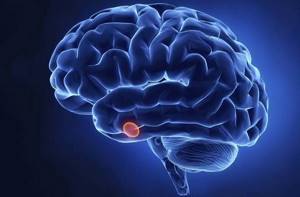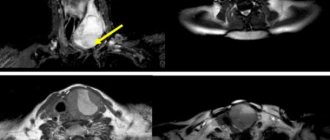The thyroid gland is one of the organs involved in the hormonal regulation of human life. It is located in the anterior part of the neck, anatomically represented by two lobes and an isthmus between them. The shape of the thyroid gland resembles a butterfly. Despite its small size, the gland takes on a significant amount of the functional load for the production of hormones.
Location and structural features of the organ
The thyroid gland is located on the front of the neck, below the hyoid bone. Its lateral lobes are located at the height of the cricoid and thyroid cartilages. The lower pole of the organ is located at the level of the fifth and fourth tracheal rings, and its weight reaches 30 grams in an adult.
Content:
- Location and structural features of the organ
- Features of blood supply and functioning of the thyroid gland
- Enlarged thyroid gland: what is it and why does it appear?
- Causes, degrees and stages of organ enlargement, manifestations of pathology
- Characteristic types of gland enlargement process
- Symptoms of pathology: how to detect the disease
- Increase in organ shares: why does it happen?
- Change in the size of the thyroid isthmus
- Development of pathology in women, men, children
- P https://izmenenie-razmera-peresheyka-shchitovidnoj-zhelezyconsequences and complications of the disease
- Treatment of an enlarged thyroid gland
In front, the gland is covered by skin, subcutaneous fatty tissue and four fascia: superficial, second fascia (superficial plate), subtracheal plate of the fascia of the neck with the hyoid muscles. The most superficial of all is the sternohyoid muscle, below it is the sternothyroid muscle.
In a fixed position, the thyroid gland is supported by a ligament - a thickening of the pretracheal plate of the fascia of the neck, which secures the organ to the adjacent cartilage and trachea. Under the muscles and the third fascia there is a parietal plate of the fourth fascia, fused with it. In the direction of the midline of the neck, the second fascia fuses with the overlying fascia, and together they form the white line of the neck.
Further, behind the pariental leaf of the fourth fascia there is fiber of the interfascial suprasternal space, which is limited from behind by the visceral leaf of the fourth fascia, forming the thyroid capsule - its protective outer shell, surrounding the organ on all sides. Under the capsule, around the gland itself, there is loose fiber with vessels and nerves passing to the gland. The capsule is not closely and directly connected to the gland, due to which, for example, during surgery, by cutting the capsule, the lobes of the thyroid gland can be moved. In addition, the organ also has an internal fibrous capsule directly connected to the parenchyma by septa.

The upper pole of the lateral lobes of the thyroid gland reaches the level of the middle height of the cartilaginous thyroid plates, and the lower one descends under the isthmus and to the level of the fifth and sixth rings, 2-2.5 centimeters higher than the sternal notch zone.
About a third of the world's population has a pyramidal lobe of the gland, which rises along the top of the isthmus, or from the lateral lobes. Additional lobes are less common. The isthmus is located in front of the trachea; in rare cases, the anatomical features of the structure of the gland do not suggest the presence of an isthmus.
Connective tissue septa, which extend from the capsule into the parenchyma, divide it into lobules, in turn consisting of follicles. The follicular walls are lined from the inside with single-layer cubic epithelium. Inside the cavities of the follicles there is a liquid colloid containing ribonuclein, proteins, iodine, thyroglobulin and other enzymes.
Features of blood supply and functioning of the thyroid gland
The organ is supplied with blood through four arteries - two upper ones, arising from the external carotid artery, and two lower ones, arising from the thyrocervical section of the subclavian artery. The fifth azygos artery occurs in rare cases and arises from the innominate artery or aortic arch. Accordingly, a person has a similar number of paired veins.
The innervation of the organ occurs due to the sympathetic and parasympathetic nerves.
One of the main functions of the thyroid gland is the secretion of iodinated hormones:
- thyroxine;
- triiodothyronine.
The basis for the formation of hormones is iodine and the amino acid tyrosine. Iodine enters the body with food, air, and water in the form of inorganic or organic compounds. Excess of the element is excreted in bile and urine. In the blood, its organic compounds form sodium and potassium iodides, and under the influence of oxidation by enzymes they are converted into iodine.

Thyroxine is a thyroid hormone that affects metabolic processes and regulates development and growth processes in the body. In brain cells, oxidative reactions occur with its participation. An imbalance in its concentration causes the development of various pathologies - myxedema, cretinism. In addition, protein production processes directly depend on the amount of thyroxine.
Triiodothyronine is released during the deiodination of thyroxine in the liver and kidneys. The thyroid gland also produces it, but in smaller quantities.
Due to the production of iodinated hormones in the body, the thyroid gland affects:
- functioning of the central nervous system;
- higher nervous activity;
- growth, development of the body;
- metabolism;
- autonomic system (muscle contractions, respiratory movements, sweating processes);
- the ability of blood to clot.
Calcitonin (thyrocalcitonin) is a non-iodized hormone, that is, it does not contain iodine. Its amount directly affects the amount of phosphorus and calcium in the blood; under its influence, the amount of these substances decreases. The hormone is produced by parafollicular cells of the thyroid gland, located outside the follicles.
All hormones produced are involved in metabolic processes to maintain life, and also affect the functioning of the digestive organs, respiratory, reproductive and nervous systems.
We take a test for thyroid hormones (test for thyroid hormones)
An important role for women is to take tests to determine the norm of thyroid hormones. To ensure the result is as accurate as possible, you must adhere to the following rules:
- the last meal should be 8 hours before the test;
- within 8 hours it is allowed to drink only clean water without gas;
- Smoking and drinking alcohol are prohibited at least 24 hours before blood collection;
- the analysis is submitted before 12 o'clock in the morning, in an emotionally calm state;
- It is also necessary to stop taking hormonal medications one day before. If this is not acceptable, then you need to warn the doctor before taking blood.
The next step for women in determining a possible pathology of the thyroid gland will be an ultrasound, which will help determine the norms or abnormalities in the structure of the gland.
Enlarged thyroid gland: what is it and why does it appear?
In its normal state, the organ is not visible to the eye and cannot be felt with the fingers. However, there are some pathologies in which the thyroid gland enlarges, sometimes to such a size that a person develops a large goiter on the neck.
An enlarged gland is a common symptom of diseases that affect people of various age categories. They are dangerous because they cannot always be detected in the initial stages, and the changes that occur in the body can be the beginning of irreversible processes.
An enlarged thyroid gland itself is not always a pathologically dangerous condition, and does not even require emergency treatment in all cases - it all depends on the etiology.

Doctors distinguish 3 stages of changes in organ size:
- Stage 1: normal, no changes;
- Stage 2: the thyroid gland has increased in size, but it is not visible during examination, it does not deform the neck, the organ can only be felt;
- Stage 3: the increase is noticeable to the naked eye, especially when turning the head, it deforms the contours of the neck.
In addition, the degrees of enlargement of the thyroid gland are known:
- 0 degree: no increase or slight increase, in which the organ is not visible to the eye and cannot be felt;
- 1st degree: the isthmus is determined by palpation, the organ is not visually visible;
- 2nd degree: both lobes and the isthmus can be felt, the organ becomes noticeable when swallowing;
- 3rd degree: visual enlargement is noticeable, the neck becomes more rounded in appearance because of this;
- 4th degree: entails a change in the shape of the neck, the lateral parts of the organ extend beyond the outer edge of the sternomastoid muscle;
- Grade 5: large, clearly visible goiter, which apparently deforms the neck.
According to the International Classification of Diseases 2010 (ICD 10), pathologies designated by codes in the range E00-E07 are diseases of the thyroid gland.
Causes, degrees and stages of organ enlargement, manifestations of pathology
There are various reasons for an increase in the size of an organ, among which doctors often mention:
- lack of iodine, selenium and fluorine in the diet (especially in children);
- the influence of negative environmental factors, for example, toxic or radioactive substances;
- the presence in the blood of substances that interfere with the production of thyroid hormones (aminosalicylic acid, resorcinol, sulfonamides);
- lack of vitamin D;
- viral and bacterial lesions that inhibit the functioning of the thyroid gland;
- chronic state of stress;
- lack of physical activity;
- hereditary predisposition;
- diseases and malformations of the hypothalamus and pituitary gland, which work in direct connection with the thyroid gland.

Such causes and diseases become a catalyst for the development of various pathological syndromes associated with organ enlargement:
- hypothyroidism;
- hyperthyroidism;
- euthyroidism.
Hypothyroidism is a condition of insufficient production of thyroid hormones as a result of iodine deficiency. Against this background, the organ begins to work more intensively and, accordingly, grows in volume. The pathology can be primary or secondary: in the first case, the condition develops as a result of dysfunction of the thyroid gland itself, in the second - due to diseases of the hypothalamus and pituitary gland, as well as due to a lack of thyroid-stimulating hormone of the pituitary gland.
Hyperthyroidism is characterized by increased secretion of hormones, causing its concentration to exceed normal values. It usually develops against the background of toxic diffuse goiter (Graves' disease), inflammation of the thyroid gland, tumor growths in it, in the hypothalamus or pituitary gland. The condition is accompanied by increased metabolic processes.
With euthyroidism, the thyroid gland is enlarged with normal hormones, that is, the results of tests for thyroid hormones do not show any abnormalities. This pathology develops as a consequence of the compensatory function of the body - in this way it tries to cope with iodine deficiency. The pituitary gland intensively produces thyroid-stimulating hormone, thus maintaining the functioning of the thyroid gland.
Euthyroidism is a condition that occurs in adolescents during puberty, as well as in pregnant women or women during menopause. It can also form as a side effect of taking certain medications.
How to determine whether euthyroidism is a disease or not? Doctors call this condition borderline between normal and pathological - that is, functional changes in this case can develop, but not necessarily in every case. We can talk about the presence of pathology when there is growth of the thyroid gland, but the level of hormones it produces remains stable.
To diagnose euthyroidism, hypo- and hyperthyroidism syndromes, the patient is examined and interviewed; Ultrasound of the thyroid gland is prescribed. After this, the patient is referred for hormone tests to determine thyroid hormones. If the results of an ultrasound examination are insufficient, the patient may be prescribed MRI and radioisotope diagnostics. Usually, if euthyroidism is detected during pregnancy or in a teenager, no special therapeutic measures are prescribed - doctors prefer to monitor the condition and functioning of the organ.
Factors influencing thyroid enlargement
The first factor that provokes an enlarged thyroid gland and goiter is a lack of iodine in the body. Catastrophically low iodine levels can lead to goiters weighing up to 2 kg. Often such cases are irreversible, even with qualified medical assistance. In this case, the patient will have to take certain hormones that control thyroid volume for the rest of her life.
Another equally dangerous factor is the increased production of your own hormones. In medical practice, this phenomenon is called hyperthyroidism. This disease is characterized by increased levels of hormones and has a number of causes:
- prolonged depression, emotional exhaustion;
- severe daily fatigue;
- accelerated metabolism.

Pathology requires immediate treatment. Otherwise, the risk of cardiovascular diseases increases significantly.
There are also other factors that can influence the size of the thyroid gland, namely, its enlargement:
- chronic diseases of various systems or organs;
- alcohol abuse or smoking;
- ecology;
- unbalanced diet;
- constant stress;
- weak immune system.
The reasons described above are the main ones in the disruption of a woman’s hormonal levels, which entails an increase in the thyroid gland. The largest percentage of this phenomenon is observed in women during puberty, menopause and childbearing age. Diagnosis of the organ in these periods is very important, since untimely treatment of the pathology leads to serious complications.

Characteristic types of gland enlargement process

Enlargement can manifest itself in several types. Thus, the presence of a diffuse goiter indicates a uniform change in the size of the organ, and nodular enlargement occurs with the formation of local nodes over the entire area of the gland. With nodular enlargement, due to a lack of iodine, thyrocytes partially escape the control of the thyroid-stimulating hormone produced by the pituitary gland, as a result of which nodes are formed (seals similar to tumor formations, increasing the overall volume of the organ). If fluid accumulates in the node, the patient is considered to have a cyst. This type of goiter is more often found in people over 50 years of age.
Another classification of pathology is based on the reasons that provoke it. Depending on the etiology, goiter can be:
- endemic;
- sporadic.
Endemic goiter is formed as a result of a lack of iodine in the environment around the body, while sporadic goiter develops in those people who have everything in order with the amount of iodine in their diet. Like endemic, it can be nodular, diffuse or mixed. Its development is provoked by poor ecology, exposure to radioactive substances, and hereditary predisposition.
In addition to visual changes in the contours of the neck, deviations in the organ can be detected by palpation, paying attention to changes in its density and mobility. Normally, the organ has an elastic and soft texture. When swallowing, it moves normally along with the cartilage.
Symptoms of pathology: how to detect the disease
In what cases can you suspect an enlarged thyroid gland? The development of pathology in a person is most often accompanied by the appearance of certain symptoms.
The first signs of abnormalities in the functioning of the organ are:
- weight fluctuations: an increase or decrease in body weight for no apparent reason may indicate that the gland produces insufficient or excessive amounts of hormones;
- visual change in the contours of the neck: with the formation of a medium or large goiter, it becomes more rounded and powerful;
- heart rhythm disturbance: hypothyroidism provokes a stable slowdown of the heartbeat, hyperthyroidism causes its acceleration;
- cough of a reflex nature: if the gland increases sharply or gradually, it begins to occupy more volume than normal and interferes with normal breathing and the swallowing process, causing in some cases the feeling of a lump in the throat;
- decreased body tone, feeling of chronic fatigue: a person in this case feels lethargic, irritable, has problems sleeping, changes in behavior;
- hair loss: causeless thinning of hair should alert you, since the problem may not be a lack of vitamins, which is usually the first fault;
- feeling of heat and chills: pathologies of the thyroid gland directly affect the processes of thermoregulation of the human body, therefore, due to hypothyroidism, the patient may often and without reason feel chills without an increase in temperature, and with hyperthyroidism, a fever with severe sweating.
In addition, a person should be alerted to the sensation of pain when swallowing food or swallowing saliva - this may be a sign of the formation of nodular formations in the parenchyma of the organ. To the touch, the enlarged gland is dense and hard. During swallowing, it does not move, although normally it should move freely along with the cartilage. When pressing, pain may not be felt, but palpation is usually accompanied by discomfort.
You should also pay attention to the following symptoms:
- dry skin and brittle nails;
- constipation or diarrhea;
- numbness or tingling in the fingers; menstrual cycle disorders in women;
- vision problems;
- muscle weakness.
Are the lymph nodes connected to the thyroid gland? Of course, those lymph nodes that are located in close proximity to the organ can respond to changes in its functioning. Inflammation of the lymph nodes is a symptom characteristic of inflammatory thyroid disease. It is also observed when neoplasms appear in the organ.
Recognizing thyroid pathologies in women
As mentioned above, thyroid problems can masquerade as diseases of other organs and systems. But there are basic signs by which one can suspect disturbances in the functioning of the thyroid gland:
- frequent feeling of fatigue;
- absent-mindedness;
- sudden weight gain or loss;
- disruptions in the menstrual cycle;
- decreased sex drive;
- increased nervousness;
- drowsiness during the day;
- noticeable skin problems (dryness, rashes);
- disruption of the gastrointestinal tract (diarrhea, constipation).

Increase in organ shares: why does it happen?
It is known that the thyroid gland consists of a right and a left lobe, sometimes additional lobes are also formed in it. Normally, the right lobe is always slightly enlarged relative to the left. The normal weight of the thyroid gland according to average indicators is about 30 grams. An increase can occur not only in the entire volume of the organ, but also in a separate lobe, especially against the background of an inflammatory process or the formation of a benign cyst.
Multiple cysts are diagnosed quite rarely; basically, they are single in nature.
If the left lobe is enlarged, pathological processes and diseases are suspected in the patient. Most often, the cause is benign cysts. The size of cysts reaches up to 3 centimeters - such formations do not cause pain. If the cyst grows by more than 3 centimeters, it already causes pain. This is explained by the fact that the increasing formation compresses nearby organs with the left lobe. In addition to pain, the patient has hoarseness in the voice, cough, and sore throat. There is an asymmetrical change in the size and shape of the neck - a growing increase appears on the left side.
Ultrasound of the gland: results
Ultrasound of the thyroid gland can show either clear outlines or blurry ones. Normally, the thyroid gland should have clear outlines. If the silhouette of the organ is blurred, the development of pathology should be suspected.

According to the structure of the thyroid tissue, the thyroid gland can be either homogeneous or non-uniform. If a woman’s thyroid gland is normal, then its tissue will be granular in nature. An experienced diagnostician can easily determine this. In the case when the pathological process has begun to develop, the tissue structure is heterogeneous. Diagnosticians may describe this phenomenon in different ways, but its essence is that the tissue acquires some “holeiness”, the graininess becomes heterogeneous. If you look at the photo, you will notice a combination of light spots and dark ones.
An important role in the diagnosis of the thyroid gland is played by the norm of echogenicity, or more precisely, its tone. Normally, the tone of the thyroid gland will coincide with the tone of the muscle that is located near the parotid gland. When the tone is a deeper color or almost black, then pathology is clearly present.
Normally, the thyroid gland should not have nodules; only small cystic formations up to 3-4 mm are allowed. During an ultrasound, they will appear as small black spots. However, such formations in medicine are not considered a pathology, since they do not have a negative effect on the body.
The normal functioning of all organs and systems, beautiful skin, strong hair - the thyroid gland provides us with all this. Any woman should have information about the state of health, size and norm of the organ. It is the control of the thyroid gland that helps prevent many diseases.
Change in the size of the thyroid isthmus

Enlargement of the isthmus of the organ is a rather rare occurrence, but it always indicates that pathological changes are occurring in it.
The isthmus is the connection between the left and right lobes. It is located in the area of the second and third tracheal cartilage. In some cases, the isthmus is located at the level of the arch of the cricoid cartilage or the first tracheal cartilage. A normal isthmus is an elastic, painless fold that has a flat and smooth surface.
The main reason for the increase is hormonal changes in the body. The problem may be the growth of metastases from nearby organs, or from the thyroid lobes.
Development of pathology in women, men, children
Why does the thyroid gland enlarge in women?
The thyroid gland in women is somewhat more susceptible to changes in size due to frequent hormonal imbalances to which they are prone.
If the organ is not able to cope with the load, a hormonal imbalance begins in the human body, and the woman notices menstrual irregularities, delays, and difficulties conceiving a child. The patient feels trembling in her hands, her health worsens, her hair falls out and becomes dull, and her nails break.
An enlarged thyroid gland for a woman negatively affects the process of puberty, pregnancy, and menopause. During pregnancy and childbirth, a woman’s organ is especially vulnerable, and in order to protect it from stress, and the body from infection, decreased immunity and iodine deficiency, iodine-containing drugs are often prescribed.
Enlarged thyroid gland in men
Pathology appears less frequently in men, since their thyroid gland has a slightly different anatomical structure. Thus, even the initial stages of enlargement in a man can be immediately visually noticed, and for this there is no need to do an ultrasound or go to an endocrinologist.

Hyperfunction in men manifests itself in sudden weight loss, changes in behavior - the patient becomes more excited, talkative and restless. His fingers tremble, there is increased sweating, weakness, sexual dysfunction, and arrhythmia. All this happens against the background of a goiter growing on the neck.
Hypofunction of the organ is accompanied by increased fatigue and fluctuations in pressure, constant chills and causeless weight gain. In addition, erectile dysfunction is present.
Another type of enlargement of the thyroid gland is associated with the development of thyroiditis with rapid progression. The patient develops increased sensitivity to low temperatures, difficulty swallowing, and gray hair appears early. This disease tends to be hereditary and has a negative impact on reproductive function.
Child development pathology
An enlarged thyroid gland in a child is a common abnormality. The main reason for the appearance lies in the lack of iodine in food and fluid consumed, which is superimposed on a hereditary predisposition.
In addition, the disease can develop in children living in environmentally unfavorable areas, for example, with increased levels of radioactive particles in the air, soil, and water.
At the beginning of the onset of pathology, it is difficult to detect it in a child, since it goes unnoticed. Symptoms of the disease gradually increase - weakness, sleep disturbances, weight fluctuations up or down. Drowsiness alternates with insomnia, swelling of the body, shortness of breath, and increased excitability appear. Such manifestations are often attributed to a seasonal lack of vitamins, or age-related changes.
Prevention involves periodic visits to the doctor, starting in infancy.
Thyroid diseases in adolescents
For this age category, an enlarged thyroid gland is a pressing problem that appears as a result of hormonal age-related changes and puberty. A significant role in this process is played by hereditary predisposition, the presence of congenital diseases, and iodine deficiency. Symptoms have similarities with pathology in children and adults.
Due to the body's increased need and lack of iodine, vitamins and microelements, a teenager may develop sporadic and endemic goiter. Diffuse toxic goiter appears in people during puberty, and develops against the background of infectious diseases, chronic infectious processes in the nasopharynx, and hereditary predisposition.
Normal size of a woman's thyroid gland
The thyroid gland in its normal state looks like two butterfly-shaped lobes connected by a bridge. Sometimes a third lobe occurs, but this is not considered a pathology and does not affect the functioning of the organ.
The size of the thyroid gland can be from 20 to 40 mm - this will be considered the norm. The isthmus between the lobes is no more than 5 mm. As for the normal volume of the thyroid gland in women, it is calculated using an ultrasound examination. The normal volume of the thyroid gland in women after 50 years is considered to be no more than 18 cubic cm.
The norm and size of the thyroid gland in women is usually calculated based on body weight, the table below is presented:
- from 50 kg - 15.4-15.5 mm;
- from 60 kg - 18.6-18.7 mm;
- from 70 kg - 19.9-20.0 mm;
- from 80 kg - 24.9-25.0 mm;
- from 90 kg - 28.3-28.4 mm;
- from 100 kg - 32.0-32.2 mm.
The normal thyroid gland level in girls is different from the normal level in women. It is measured according to age parameters and looks like this:
- 6 years - 4.9-5.0 mm;
- 7 years - 6.3-6.4 mm;
- 8 years - 6.7-6.8 mm;
- 9 years - 8.0-8.2 mm;
- 10 years - 9.3-9.4 mm;
- 11 years - 9.8-9.9 mm;
- 12 years - 11.7-11.8 mm;
- 13 years - 13.8-13.9 mm;
- 14 years - 14.9-15.1 mm;
- 15 years - 15.6-15.8 mm.
Note that during a period of hormonal surge, for example, pregnancy or puberty, the thyroid gland can significantly increase in size.
When hormonal levels return to normal, the organ returns to its previous size. After the onset of menopause, the thyroid gland decreases slightly.

Consequences and complications of the disease

Like many other pathologies and diseases, an enlarged thyroid gland rarely goes away without negative consequences. They can be reversible, or provoke irreversible changes.
As a result of an enlarged thyroid gland, the patient experiences digestive disorders and disturbances, increased sensitivity to temperature fluctuations, weight loss or gain, and insomnia, which is replaced by drowsiness.
Increased production of hormones provokes an acceleration of all processes in the body and increased intestinal motility, resulting in diarrhea. Accordingly, with reduced hormone synthesis, peristalsis slows down, and the patient experiences constipation and bloating.
Excessive concentration of hormones in the blood also speeds up metabolism, and a person quickly loses weight. Against this background, sleep disturbance appears, and over the course of several days the patient can sleep for only a few hours. In this case, there is an increase in body temperature and severe sweating. A lack of thyroid hormones, on the contrary, causes weight gain, drowsiness, a decrease in temperature and a constant feeling of chills.
In addition, the consequences of an enlarged thyroid gland are:
- feverish conditions;
- impaired clarity of consciousness;
- tachycardia;
- rave;
- disorders of the central nervous system;
- dysfunction of hearing, vision;
- disorders of the respiratory system.
If the disease is not adequately treated, it can develop into serious complications and conditions. In some cases, patients develop hypothyroid coma or thyrotoxic crisis. During a coma, the body temperature drops below 35 degrees, and the brain begins to suffer from oxygen starvation. A crisis, on the contrary, is accompanied by a high temperature (up to 41 degrees), delirium and hallucinations, and a decrease in blood pressure. Both conditions can result in the death of the patient.








